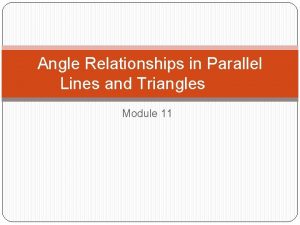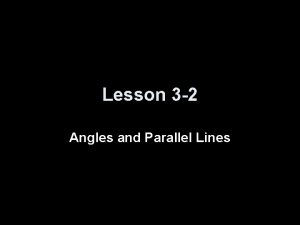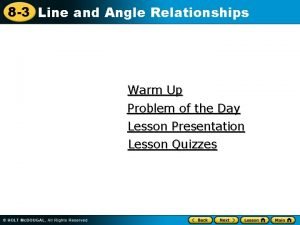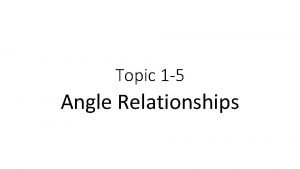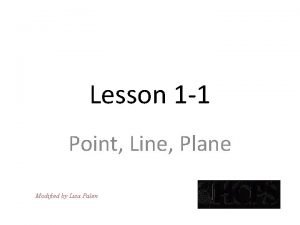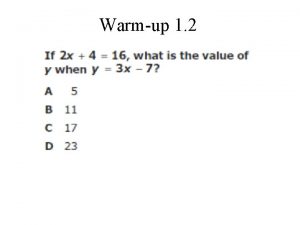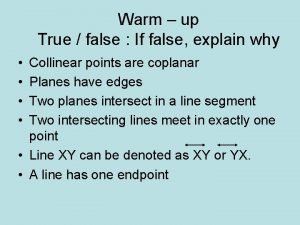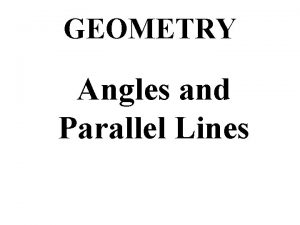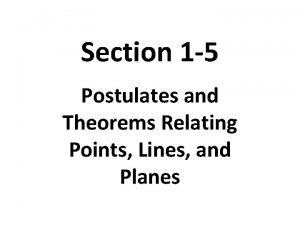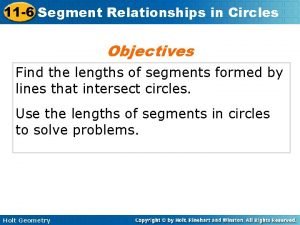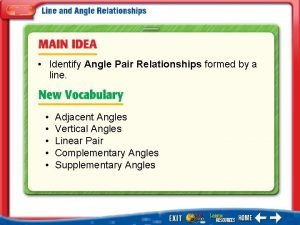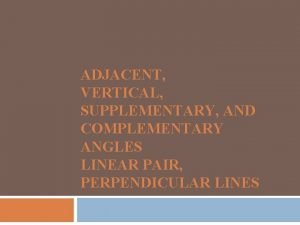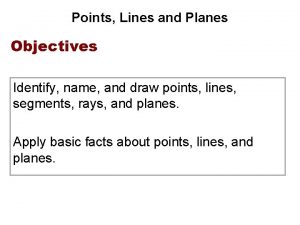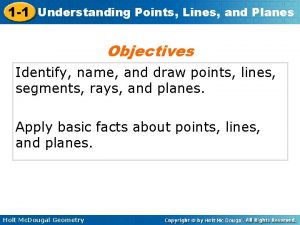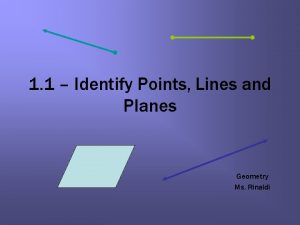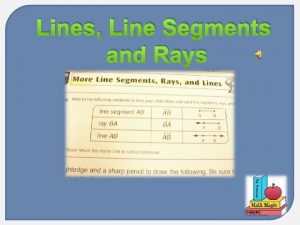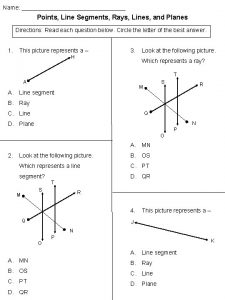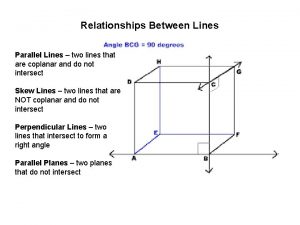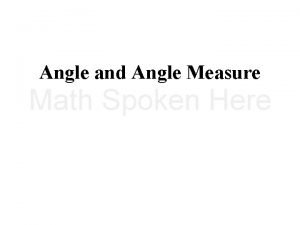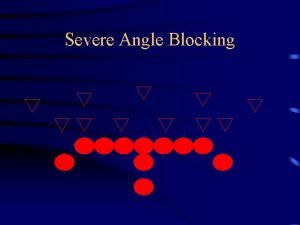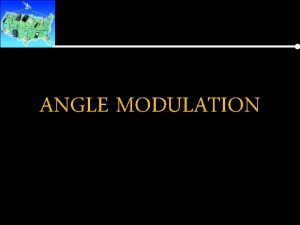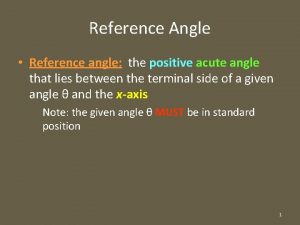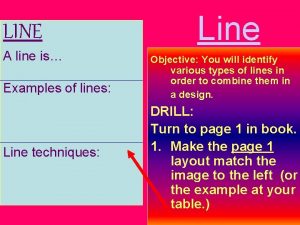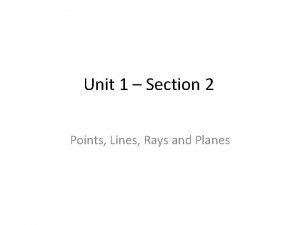Line and Angle Relationships Points Lines and Rays

























- Slides: 25

Line and Angle Relationships

Points, Lines, and Rays • Sometimes it’s necessary to refer to a specific point in space • Points have no size • The only function of a point is to show position • . A or Point A

Points, Lines, and Rays • If you draw two points on a sheet of paper, a line can be used to connect them • Lines need names just like points do, so we can refer to them easily • Line segment AB or • Line AB or AB

Points, Lines, and Rays • Since the length of any line is infinite, we sometimes use parts of a line • A ray is the part of a line that extends without end in one direction • In “ray AB, ” ( ) A is the endpoint • The second point that is used to name the ray can be any point other than the endpoint (You could also name it ray AC)

Points, Lines, and Rays • A plane is a set of line segments or sides that connect to form a closed figure • Plane ABCD A B D C

Points, Lines, and Rays Checkpoint • Look at the line below: 1. 2. 3. Name a line segment Line segments AB, AC, BA, BC, CB, and CA Name a ray in two different ways Ray AB and Ray AC, or Ray CB and Ray CA What is the endpoint of ray BC? B

Naming Angles • Two different rays with the same endpoint form an angle • The point they have in common is called the vertex of the angle • The rays form the sides of the angle

Naming Angles • The angle above is made up of ray BA and ray BC • B is the common endpoint • Point B is the vertex of the angle • Instead of using the word angle, you can use the symbol for angle, which is

Naming Angles • There are several ways to name an angle • Using the three letters of the points that make up the two rays with the vertex as the middle letter ( ABC, or CBA) • Use just the letter of the vertex ( B)

Naming Angles • When more than one angle is formed by a vertex, you use three letters to name each angle • Since A is the vertex of 3 different angles, each angle needs three letters to name it ( CAD, CAB, and BAD)

Naming Angles Checkpoint • Look at the angles formed by the rays below: 1. Name the vertex Y 2. Name all three of the angles Angles XYZ, XYW, and WYZ

Measuring Angles • You measure an angle in degrees using a protractor • Place the center point of the protractor on the vertex of the angle • Align the 0 degrees line on the protractor with one side of the angle • Read the number of degrees on the scale where it intersects the second side of the angle

Measuring Angles Checkpoint • Measure each angle Answers should be close to 60, 30, and 20 degrees. On my projector, the line covers about 10 degrees

Classifying Angles • An acute angle measures less than 90 degrees • A right angle measures exactly 90 degrees

Classifying Angles • An obtuse angle measures greater than 90 degrees • A straight angle measures exactly 180 degrees

Classifying Angles • A reflex angle measures greater than 180 degrees

Classifying Angles • Complementary angles are two angles whose sum is 90 degrees • Supplementary angles are two angles whose sum is 180 degree

Classifying Angles • You find the complement of an angle by subtracting it’s measure from 90 degrees

Classifying Angles • You find the supplement of an angle by subtracting it’s measure from 180 degrees

Classifying Angles • Congruent Angles are angles that have the same measure

Classifying Angles • Adjacent angles are two angles that have the same vertex, share a common side, and do not over lap

Classifying Angles • Vertical angles are two opposite and equal angles formed by the intersection of two lines

Classifying Angles Checkpoint • Name each angle below: 1) 2) Obtuse Angle 3) Acute Angle 4) Straight Angle Right Angle or 90 degree Angle

Classifying Angles Checkpoint 1. What is the relationship between angle a and angle b? Vertical Angles 2. What is the relationship between angle a and angle c? Adjacent Angles 3. Find the measure of angle d if angle a measures 85 degrees. 180 – 85 = 95 degrees

Homework • Skill 1: Lines and Angles (both sides) • Review 64 Points, Lines, Planes, and Angles (both sides) • Due tomorrow!!!
 Angle relationships in parallel lines and triangles
Angle relationships in parallel lines and triangles Worksheet section 3-2 angles and parallel lines
Worksheet section 3-2 angles and parallel lines Special angle relationships
Special angle relationships Characteristics of linear pair
Characteristics of linear pair Linear pair angles
Linear pair angles Lesson 1-3 segments rays parallel lines and planes
Lesson 1-3 segments rays parallel lines and planes Name three line segments
Name three line segments Opposite rays form a line. true false
Opposite rays form a line. true false Line vw and line xy are parallel lines drawing
Line vw and line xy are parallel lines drawing All angles
All angles Brand positioning bull's eye
Brand positioning bull's eye Point of difference and point of parity
Point of difference and point of parity A plain scale of 1cm=5m and show on it 37m
A plain scale of 1cm=5m and show on it 37m Postulates and theorems relating points lines and planes
Postulates and theorems relating points lines and planes Sudut segitiga
Sudut segitiga 2-7 proving segment relationships
2-7 proving segment relationships Angle and segment relationships in circles
Angle and segment relationships in circles Which relationships describe the angle pair x° and 50º?
Which relationships describe the angle pair x° and 50º? Linear angles
Linear angles How many planes are there in the diagram
How many planes are there in the diagram Which of the following is a line drawing algorithm
Which of the following is a line drawing algorithm Points lines and planes geometry
Points lines and planes geometry 1-1 geometry
1-1 geometry Output primitives in computer graphics ppt
Output primitives in computer graphics ppt 1-1 understanding points lines and planes
1-1 understanding points lines and planes Example of opposite rays
Example of opposite rays
